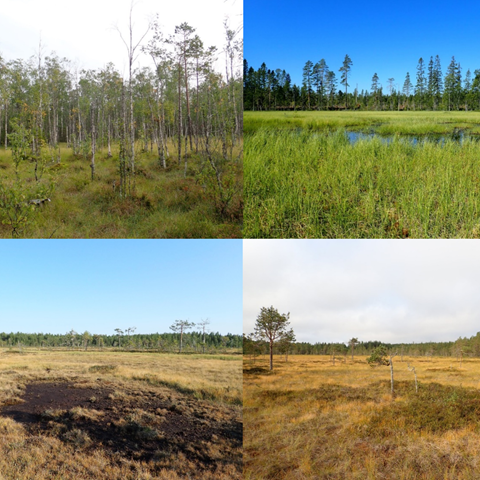Contact
Betty Ehnvall, Doctoral Student at the Department of Forest Ecology and Management; Department of Forest Ecology and Management, joint staff

In the right conditions, over millennia, northern wetlands have become one of nature's most important carbon-storing environments. But what's in this slow recipe for making mires? Using a combination of map models and peat samples, PhD-student Betty Ehnvall at SLU has traced the development of the northern coastal mires since the last ice age.
The ecology of mires has been studied for over a hundred years in Sweden. They are effective environments regarding carbon uptake and storing other substances in the soil. Globally, the growth of peat since the last ice age has had a cooling effect on the climate, because peat binds carbon that would otherwise be in the atmosphere as carbon dioxide. However, less is known about how the landscape affects the processes that govern the formation and growth of mires.
The distribution of mires along the northern Swedish coast have fortunate properties when studied. It is a unique landscape with mires formed as the inland ice melted, gradually creating new land areas. This can be used to determine their age. By combining data on elevation and geography from Lantmäteriet with new soil moisture data developed by SLU, Betty Ehnvall has been able to map a wetland landscape in various stages of development since the land emerged from the sea.
– It is primarily about mires in places where there has never been either a lake or a forest, where it's formed directly as the land rises from the sea. That is what enables us to see how the mires develop over time. On the coast, you find very young mires, and towards the inland, they become older. So, without carbon-14 dating, we can estimate their age based on how high above sea level they are, says Betty Ehnvall.
On a large scale, the mire formation primarily occurs in wetter areas, but over time, thousands of years, the mires spread even in drier areas. The results show that the patterns can be generalized at the landscape level and are the same from Haparanda in the north to Nordmaling in the south.
– The goal was to scale up different mire properties to the entire forest landscape. We can show clear changes over time depending on how the mires are situated in the landscape and their catchment areas around them. There are many assumptions about how northern mires develop, and with our results, we can demonstrate the complexity. Therefore, they can be used to improve models that describe the development of that type of mire, says Betty Ehnvall.
Moisture, age, and vegetation. Water inflow and the shape of the landscape. All these factors play a role in how the mires eventually look and function. Using peat samples from about 60 mires in an area around Sävar north of Umeå, Betty Ehnvall has been able to see how all these factors leave imprints on the ecological and carbon-binding function of the wetlands.
The study also shows that mires continue to accumulate more peat and more carbon as they get older. But it has also been observed that the more nutrient-rich mires, with a high rate of peat formation, nevertheless do not achieve a greater peat depth than others. Rather, researchers can see how mires in favorable, wet areas reach their maximum extent within a couple of thousand years. However, in drier places, mire areas continue to grow for thousands of years longer.
Looking at an entire region, the patterns in the wetland landscape are visible. However, collecting peat samples on foot, with only walking distance in between reveals a complex and changing vegetation. On one and the same mire, one square meter can be completely different from the next.
– I have sampled mires from edge to edge to cover the variation in vegetation, hydrology, and peat chemistry. In one place, typical forest species come in, then there is mostly sphagnum moss and some carnivorous sundew. And suddenly, you stand on a quagmire and feel the water movements underneath," says Betty Ehnvall, who spent two months collecting the hundreds of samples.
The collection of data on the mires around Sävar has been carefully documented with maps and images that are now available online for those who want to see them with their own eyes.
It's great to be able to show all these beautiful pictures. And also, in choosing future research subjects, scientist can choose a specific type of mire by looking here," says Betty Ehnvall.
Betty Ehnvall, Doctoral Student at the Department of Forest Ecology and Management; Department of Forest Ecology and Management, joint staff
Read the abstract and full study: https://publications.slu.se/?file=publ/show&id=123735
See maps and pictures from mire studies at Sävar (website): MC-SLU (slughg.github.io)
(May be published in news articles regarding this press release. Click the link for a high resolution image. Photographers name must be included.)
Betty Ehnvall. Photo: Peter Berglund
Mire vatiation. Photo: Betty Ehnvall
Peat sampling. Photo: Betty Ehnvall
3D-model of a mire catchment area. Photo: Betty Ehnvall